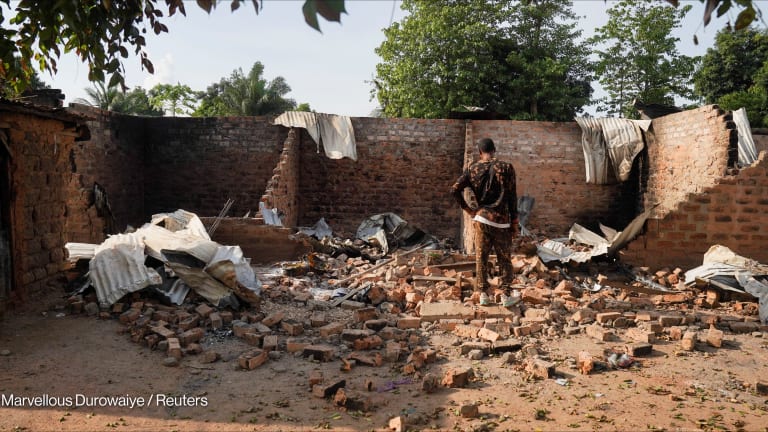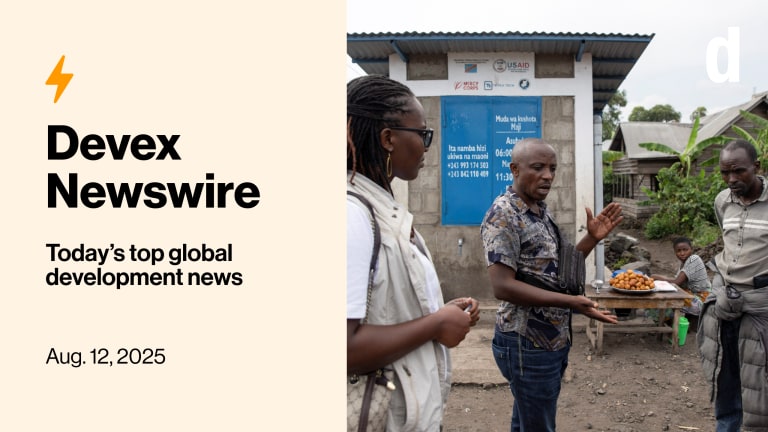USAID in ‘time crush’ to roll out landmark Global Fragility Act
The 10-year country and region-specific strategies detailing how the U.S. government will implement the Global Fragility Act will be released by the end of the year, according to the top U.S. Agency for International Development official.
An ambitious U.S. foreign aid bill designed to head off conflicts before they begin may finally be coming to fruition. The U.S. government will, by the end of this year, release its long-awaited 10-year country and region-specific pilot strategies: the Global Fragility Act, a landmark bill passed by Congress in 2019 to prevent conflict in unstable regions, according to a top U.S. Agency for International Development official. “Right now is a time crush” for country teams to develop collaborative, whole-of-country strategies to mitigate instability in conflict areas, USAID Assistant Administrator for the Bureau of Conflict Prevention and Stabilization Robert Jenkins told Devex. This also includes collaboration with local governments and civil society. Its rollout is especially timely as the war in Ukraine pushes fuel and food prices up, increasing the likelihood of social unrest around the world. The new U.S. approach to fragile contexts, which prioritizes conflict prevention, will be implemented first in four pilot countries — Haiti, Libya, Mozambique, and Papua New Guinea — as well as the region of coastal West Africa, which includes Benin, Côte d’Ivoire, Ghana, Guinea, and Togo. “One of the things we’re really trying to do … is … getting our government to focus on prevention. We’ve been talking about it for decades.” --— Robert Jenkins, assistant administrator for the Bureau of Conflict Prevention and Stabilization, USAID “Those plans are going to be coming in in draft form in the fall — so very soon — and then Washington will do its magic: We will look at them, we will have further engagement across the government but also with civil society and others to finish them up by the end of this calendar year,” Jenkins said. “And then we get to do the fun part, which is to launch and to actually start implementing these strategies,” he added. Since the GFA’s bipartisan passage in 2019, the government has consistently missed Congressionally-mandated deadlines to outline how it will fundamentally transform the way it responds to conflict, incorporating lessons learned from failed U.S. stabilization operations in Afghanistan and Iraq. The bill is meant to refocus and align U.S. priorities in unstable regions, to proactively ensure development, diplomatic, and defense officials are coordinating to head off conflict before it breaks out — a paradigm shift from the disjointed, reactive approach that has dominated U.S. policy for decades. The pandemic and administration change contributed to delays, putting the country strategies nearly two years past their original December 2020 deadline. The country and regional strategies will detail how the U.S. Strategy to Prevent Conflict and Promote Stability, released by the former Trump administration in December 2020, will be implemented in each specific context. The documents will be public once they are completed, Jenkins said, although some portions are likely to remain internal to the U.S. government. “It won’t make any sense if we have these strategies and we hold it to ourselves and don’t talk about it … There’s not going to be a secret plan,” Jenkins said. “It’s going to be iterative — it’s for 10 years — but we’re going to have to make changes. We’re going to make mistakes, and we’re going to have to share this with people.” The principles of the GFA align closely with USAID’s localization agenda, Jenkins said, because if peace is actually going to be achieved, communities have to be directly involved. The 10-year timeline mandated by the GFA is a new concept for USAID, where contracts and projects are usually much shorter — anywhere from a few months to five years. The long timeline means the agency will be leaning heavily on monitoring, evaluation, and learning, Jenkins said, because it is understood that some approaches will fail and need to be modified. The strategy is already challenging USAID operational norms — Jenkins recently signed a waiver to allow a contracting mechanism to exceed five years. The agency also convened a meeting with the ambassadors to West African countries to discuss how to develop a truly regional strategy, including how the GFA compliments existing U.S. Strategies on women, peace, security, and atrocity prevention. “That doesn’t sound like a big deal, but our government doesn’t often get five U.S. ambassadors, people from DOD, people from USAID, and people from all across State Department in a room to white board things. That’s how people do things in the private sector. Why would we want to do that in government?” Jenkins joked, describing a three-hour meeting where ambassadors workshopped GFA implementation in their region. “We’ve already started doing things differently.” Coordination among agencies — primarily the “three Ds” of diplomacy, development, and defense — is mandated by the GFA. During his nearly 24-year career, Jenkins said he’s “never seen interagency cooperation to this extent.” He has a weekly call with his State and Defense Department counterparts. Some lawmakers have criticized the Defense Department for not engaging at high enough levels compared to implementation officials at USAID and the State Department. Large hurdles remain in places such as Haiti, which has no legitimate government and a capital controlled by gangs, and Libya, which effectively has two governments. This was by design, Jenkins said. “We knew when we started to put these countries together, that it made no sense to find five places that were relatively easy and therefore we could declare success. All of the priority countries have their own challenges,” Jenkins said. “Whether it’s Haiti, whether it’s Libya, whether it’s Mozambique, whether it’s Papua New Guinea … all of these places are going to be difficult. But that's exactly why we’re looking at them. That’s exactly why we’re stepping up to the challenge. What do we do in these hard places, in these hard cases? It’s easy to have success in an easy place. It’s difficult to have success in a difficult place. That’s why we’re focused on these places,” he explained. “We work with who we can work with” on developing a strategy in Haiti, he said. The troubled nation has not had a legitimate president since Jovenel Moise was assassinated in July 2021. The USAID reorganization, championed by former Administrator Mark Green, has enabled the agency to prioritize stabilization in a new way, Jenkins said. By making a bureau specifically focused on conflict prevention and stabilization, he said, the work doesn’t get lost. “Whereas in the past, grouped with humanitarian assistance, the focus would often just inevitably have to go towards humanitarian assistance and the crisis du jour,” Jenkins said. “One of the things we’re really trying to do … is go for that long wished objective of getting our government to focus on prevention. We’ve been talking about it for decades.” Jenkins said he is excited to see change happening at USAID when it comes to conflict prevention, but recognized many hurdles remain as the world reels from the war in Ukraine and other conflicts, lingering effects of the pandemic, and climate change. “It’s a rough time to be in the peacebuilding business,” Jenkins said.
An ambitious U.S. foreign aid bill designed to head off conflicts before they begin may finally be coming to fruition.
The U.S. government will, by the end of this year, release its long-awaited 10-year country and region-specific pilot strategies: the Global Fragility Act, a landmark bill passed by Congress in 2019 to prevent conflict in unstable regions, according to a top U.S. Agency for International Development official.
“Right now is a time crush” for country teams to develop collaborative, whole-of-country strategies to mitigate instability in conflict areas, USAID Assistant Administrator for the Bureau of Conflict Prevention and Stabilization Robert Jenkins told Devex. This also includes collaboration with local governments and civil society.
This story is forDevex Promembers
Unlock this story now with a 15-day free trial of Devex Pro.
With a Devex Pro subscription you'll get access to deeper analysis and exclusive insights from our reporters and analysts.
Start my free trialRequest a group subscription Printing articles to share with others is a breach of our terms and conditions and copyright policy. Please use the sharing options on the left side of the article. Devex Pro members may share up to 10 articles per month using the Pro share tool ( ).
Teresa Welsh is a Senior Reporter at Devex. She has reported from more than 10 countries and is currently based in Washington, D.C. Her coverage focuses on Latin America; U.S. foreign assistance policy; fragile states; food systems and nutrition; and refugees and migration. Prior to joining Devex, Teresa worked at McClatchy's Washington Bureau and covered foreign affairs for U.S. News and World Report. She was a reporter in Colombia, where she previously lived teaching English. Teresa earned bachelor of arts degrees in journalism and Latin American studies from the University of Wisconsin.








